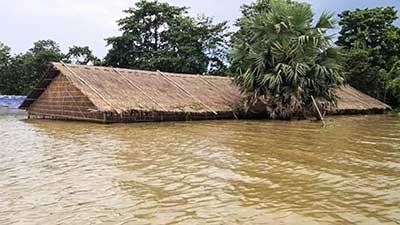Relevance: GS-3: Disaster and Disaster Management.
Key Phrases: Disaster-Free Floods, Hazard Prevention, Minimisation of disaster risk, Flood risk management strategies, Assam floods, District Disaster Management Agency, Aspirational District Programme.
Why in News?
- Assam has been ravaged by two bouts of floods in quick succession. At the peak of floods in May, some 31 districts, more than 2,000 villages, 7 lakh people and 95,000 hectares of land got affected.
Disaster Risk Reduction
- Disaster risk reduction (DRR) sometimes called disaster risk management (DRM) is a systematic approach to identifying, assessing and reducing the risks of disaster.
- It aims to reduce socio-economic vulnerabilities to disaster as well as deal with the environmental and other hazards that trigger them.
Impacts of Flood Disasters:
- What flood events share in common is their ability to cause widespread community disruption, displacement, economic loss, property damage, deaths, injury, and profound emotional suffering. Infrastructure, property, agricultural endeavours, and historical and cultural sites may also be affected by flood disasters.
Reducing Cause of Vulnerability:
- The overall aim has to move away from hazard prevention to the minimisation of disaster risk.
- Hazards like floods - fluvial or pluvial - are often triggered by extreme weather events, but they translate into disaster risk due to anthropogenic factors. The latter share a complex relationship with biophysical and social vulnerability.
- A logical corollary of this is to move away from solely focusing on structural interventions and river engineering to prevent floods and rather address the underlying factors that drive the multiple dimensions of vulnerability.
- It is only by reducing the causes of vulnerability that one can contribute to building people’s resilience.
What Needs to be Done?
- The riparian population and their lives and livelihoods should be at the centre of the planning process of flood management.
- Flood risk management strategies would need to expand their scope from river engineering and embankment construction and address the diverse root causes through a set of interventions targeted to address the drivers of vulnerability.
- Risk management cannot be done just by the water resources department. It needs convergence across multiple departments.
- In the overall flood risk management strategy, the role of agriculture, animal husbandry, education, PHED and health departments are as important.
- Strategies should include round-the-year developmental activities.
- A national programme like Swachh Bharat has demonstrated the efficacy of working on a mission mode. In this case, the mission has to ensure that communities not just live with floods but thrive despite floods. This would require a range of development interventions - including new models of embankment management — to improve the overall livelihood of rural people.
- Climate scientists predict an increase in the frequency and intensity of extreme weather events; hence, the importance of warning systems will continue to increase.
- From a risk management perspective, warning technologies are only as good as their reach in remote villages. It is here that the convergence with the tiered community institutions promoted under the National Rural Livelihoods Mission becomes important.
- With proper training, these institutions could act as a response force of the community to calamities in disaster-prone areas.-
How Dealing With Flood Risk is a Management Problem?
- Flood risk management requires dedicated and trained professionals who understand the interdisciplinarity required to manage flood risk and build resilience.
- This set of professional cadres could be located at the district level, working closely with District Disaster Management Agency and district administration and coordinating with the various line departments.
- The Aspirational District Programme has assigned a key role to its fellows in catalysing development action.
- Along similar lines, there could be District Disaster Management fellows - a dedicated group of trained young professionals with a time-bound and goal-driven assignment.
- This is an opportunity for the state government, philanthropic agencies, development implementers and academic institutes to come together and develop such a cadre of professionals.
Conclusion:
- In this hour of crisis, it is apt to reflect on what Prime Minister had said a couple of years ago when the country was still experiencing the initial shock of Covid-19 - “turning a crisis into an opportunity”.
- Restated in this context, it would mean turning the seasonal flood-related crisis into an opportunity to bring a paradigm shift in flood management.
Source: Indian Express
Mains Question:
Q. What is Disaster Risk Reduction? What strategies government should adopt for flood disaster risk reduction? Discuss.








